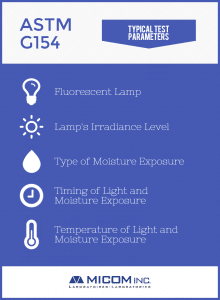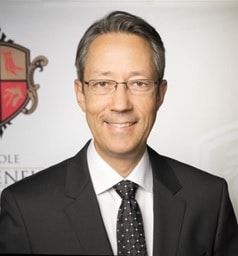The Difference between ASTM G154 and G155 and Which is Right for You
When it comes to UV exposure testing, many tests, standards and methods exist, and Micom is happy to offer numerous different UV tests that, alone and combined, help our customers better understand their products.
Two of our most popular UV exposure tests are ASTM G154 and ASTM G155, both of which measure accelerated weathering. And while these two tests are similar, there are a few key differences in their application and purpose that can help make either a more appropriate choice for your needs.

Infographic showing typical test parameters for ASTM G154.
The most obvious difference between the two is that ASTM G154 testing uses fluorescent light sources to simulate UVA and UVB while ASTM G155 testing uses xenon arc UV light sources to simulate exposure to natural sunlight. Both of these light sources are able to accurately predict, on an accelerated basis, the effect sunlight will have on a product. And while both of these practices can be used to simulate indoor and outdoor sun exposure, xenon arc light is more similar to natural sunlight and, for this reason, is often a good choice for testing outdoor products. With this in mind, ASTM G154, making use of a fluorescent light apparatus, often becomes the preferred choice for indoor UV testing, such as exposure to sunlight through a window.
ASTM G154 is one of several practices used to do QUV testing, which is used to simulate UV exposure for surface finishes, coatings and polymers. Because it uses fluorescent light sources, ASTM G154/QUV testing isn’t often used to assess colour changes as a function of time. If this is your intended purpose, you may consider our ASTM G155 testing with its xenon arc exposure.
Both of these UV exposure test methods offer great results and will, via accelerated weathering, give you a good indication of how well your product will perform under natural sunlight exposure.
If you have any specific questions relating to the ASTM G154 test and/or ASTM G155 test, or would like to know which may be best for your unique needs, please do not hesitate to get in touch with us.
This decision tree will help you quickly remember which UV Test you will need:
Disclaimer
All of the information and opinions contained in this blog are made with the information, and the understanding that we have reviewed at the time of publishing. However, despite our efforts, we do not offer any guarantee of their accuracy, thoroughness of our investigation or validity. The author of this blog is not liable for any inaccuracies or any losses or damages that may result from the use of the information or data contained herein. This blog has not been reviewed or verified for its accuracy by any peer group associates prior to publication.


